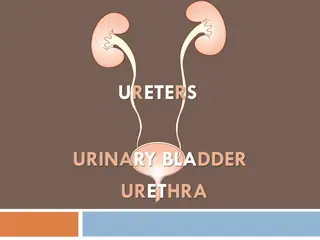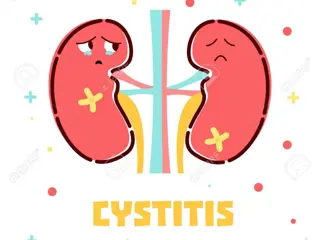Overview of Bladder Tumours: Causes, Symptoms, and Diagnosis
Bladder tumours, particularly Transitional Cell Carcinoma (TCC), are the second most common cancer in the genitourinary system. Mainly caused by factors like cigarette smoking, industrial toxins, and genetic events, bladder cancer presents with symptoms such as hematuria and irritative voiding symptoms. Diagnosis involves lab tests like urine analysis and imaging studies like ultrasonography and CT/MRI. Understanding the etiology, pathology, and clinical findings of bladder cancer is crucial for timely detection and treatment.
Uploaded on Jul 25, 2024 | 6 Views
Download Presentation

Please find below an Image/Link to download the presentation.
The content on the website is provided AS IS for your information and personal use only. It may not be sold, licensed, or shared on other websites without obtaining consent from the author.If you encounter any issues during the download, it is possible that the publisher has removed the file from their server.
You are allowed to download the files provided on this website for personal or commercial use, subject to the condition that they are used lawfully. All files are the property of their respective owners.
The content on the website is provided AS IS for your information and personal use only. It may not be sold, licensed, or shared on other websites without obtaining consent from the author.
E N D
Presentation Transcript
Bladder Tumours PROF. DR. METE K LC LER DEPARTMENT OF UROLOGY, SCHOOL OF MEDICINE, BAH E EH R UNIVERSITY
The second most common cancer of the genitourinary system The male-female ratio is 2.7/1 The peak incidence is in persons between 50- 70 years
Etiology Cigarette smoking (most common) Industrial toxins Genetic events Other risk factors (cyclophosphamide, alkylating agents, radiotherapy of pelvis.)
Pathology Histopathlogy transitional cell carcinoma 90% squamous cell carcinoma 7-8% adenocarcinoma other types Grading Grade 1 mild anaplasia Grade 2 moderate anaplasia Grage 3 marked anaplasia 1-2%
Clinical Findings A. Symptoms: Painless macroscopic hematuria 85-90% Irritative voiding symptoms B. Signs: The majority of patients have no physical signs.
Symptoms/Signs of Bladder Cancer Hematuria Irritative voiding symptoms (frequency & urgency) Masses detected on bimanual examination Hepatomegaly or palpable lymphadenopathy, lymphedema of lower extremities in patients with metastatic disease
Clinical Findings C. Lab tests: Urine test hematuria Urinary cytology depend on grade and volume of the tumor Other markers in urine BTA, NMP22, telomerase (but not so sensitive)
Lab Findings Bladder Cancer Urinalysis: microscopic/gross hematuria, pyuria Anemia due to chronic blood loss or bone marrow metastases Urine cytology is sensitive in detecting higher grade and stage lesions but less so in detecting superficial, low-grade lesions Azotemia, creatinine due to ureteral obstruction
Clinical Findings D. Imaging: Ultrasonography IVU evaluation of upper urinary tract CT/MRI assessment of the depth of infiltration and pelvic LN enlargement E. Cystoscopy (best way to make diagnosis)
Diagnosis Ultrasonography can be used as screening method to detect bladder tumors and upper urinary tract obstruction. both CT and MRI are used to see the extent of bladder wall invasion and detect enlarged pelvic lymph node.
Diagnosis Cystoscopy cystoscopy is the gold stantard to detect the bladder cancer cystoscopy can provide good information on the extent of the tumour. biopsy can be taken from suspicious area.
Pathology of Bladder Cancer Most common: urothelial cell carcinomas Rare in the US: squamous cell carcinoma (associated with schistosomiasis, bladder calculi or chronic catheter use) & adenocarcinoma Bladder CA staging based on the extent of bladder wall penetration & either regional or distant metastases Bladder CA grading based on histologic appearance: size, pleomorphism, mitotic rate & hyperchromatism Frequency of recurrence & progression strongly correlated with grade
Treatment of Bladder Cancer Transurethral resection of bladder tumor Initial therapy for all bladder cancers Diagnostic & allows for proper staging Controls superficial cancers
Treatment Superficial bladder cancer (Ta,T1,Tis) transurethral resection intravesical chemotherapy or immnotherapy(BCG) cystoscopic controls in every three months
Treatment Invasive bladder cancer (T2-T4) Partial cyctectomy solitary, inflitrating tumors localized along the posterior lateral wall or dome of the bladder. Radical cystectomy 1.muscle-invasive bladder cancer T2-T4 2.high-risk superficial tumours 3.extensive papillary disease Urinary diversion after radical cystectomy
Cystectomy Cystectomy Treatment for muscle infiltrating cancers Partial cystectomy: for pts with solitary lesions or cancers in a bladder diverticulum Radical cystectomy: bilateral pelvic lymph node dissection, removal of bladder, prostate, seminal vesicles & surrounding fat/peritoneal attachments in men & in women also the uterus, cervix, urethra, anterior vaginal vault & usually the ovaries
Treatment Radiotherapy Modern 3D-radiotherapy is a reasonable treatment option in patients who wish to preserve their bladder Chemothery chemothery for metastatic disease.
Prognosis-Bladder Cancer At initial presentation, approximately 50- 80% of bladder cancers are superficial Lymph node metastases & progression are uncommon in such patients when properly treated & survival is excellent at 81% Long-term survival for patients with metastatic disease at presentation is rare
For more information visit at: https://youtu.be/k-xtn71MUG4























